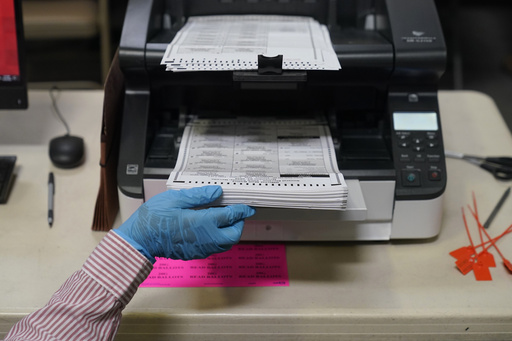
WASHINGTONG — Nevada is poised to host a series of competitive races that could shape control of both the White House and the U.S. Senate. This state is one of ten where residents will vote on a significant ballot measure regarding abortion, a topic that gained attention following the U.S. Supreme Court’s overturning of Roe v. Wade in 2022.
With six electoral votes, Nevada is the smallest prize among seven presidential battleground states considered crucial by both Democratic Vice President Kamala Harris and Republican former President Donald Trump in their quests for the presidency. The candidates have made numerous campaign stops in Nevada since securing their nominations earlier this summer.
In the Senate race, incumbent Democrat Jacky Rosen seeks re-election against Republican Sam Brown, a retired Army captain who previously ran for the GOP nomination for another Senate seat in 2022.
Additionally, voters will make decisions on several ballot measures that aim to secure abortion rights in the state constitution, mandate photo identification for voters, and implement a nonpartisan ranked-choice voting system for future elections.
Nevada has consistently served as a presidential indicator, having favored the candidate who won the presidency in 27 out of the last 30 elections. The state has only leaned towards the losing candidate in 1908, 1976, and 2016, when Hillary Clinton, a Democrat, carried it. Furthermore, Democrats have emerged victorious in Nevada in the last four presidential elections.
Election Day is set for November 5, with polls closing at 10 p.m. ET. The six presidential electoral votes will be awarded to the statewide winner.
Key races include:
- Presidential: Harris (D) vs. Trump (R) vs. Chase Oliver (Libertarian) vs. Joel Skousen (Independent American Party) vs. “None of these candidates.”
- U.S. Senate: Rosen (D) vs. Brown (R) along with others and “None of these candidates.”
- Ballot measures: Question 6 (Right to abortion), Question 3 (Top-five primary and ranked-choice general election), Question 7 (Requirement for photo ID to vote).
Other notable races include contests for the U.S. House, state Senate, state Assembly, state Supreme Court, and Washoe County commissioner positions.
Nevada mainly conducts elections via mail. A law was passed in 2021, mandating that mail-in ballots be sent automatically to active voters, thus making permanent a temporary measure that was enacted during the COVID-19 pandemic. In the 2022 midterms, around 80% of voters cast their ballots in-person or by mail before Election Day.
Mail ballots postmarked by Election Day can be counted if received by November 9, four days after the close of polling. As a significant number of mail-in ballots may arrive post-Election Day, the results of highly competitive races might remain undetermined until these ballots are counted. Despite challenges from state Republicans against this law, a federal court dismissed the lawsuit in July. Historically, mail ballots counted after Election Day tend to favor Democratic candidates.
While most votes are submitted by mail, in-person voting remains an option on Election Day. Notably, the state refrains from releasing any voting results until every voter in line has cast their ballot, which may extend past the official closing time for polls.
In statewide elections, Democrats typically win in only two of Nevada’s 17 counties: Clark, home to Las Vegas, and Washoe, home to Reno. Their success hinges significantly on their performance in these two populous regions. Clark County, which accounts for 69% of the total statewide vote as of 2020, is essential for Democratic victories.
In the 2022 midterm elections, the Republican candidates for U.S. Senate and governor initially appeared to take a lead after the first votes were reported. However, as mail ballots were counted, the dynamics shifted. Democratic Senator Catherine Cortez Masto eventually secured the lead against Republican Adam Laxalt days after Election Day, leading to her eventual victory. Conversely, Republican Joe Lombardo maintained a narrow edge to win the governor’s race against Democrat Steve Sisolak.
In terms of election projections, the reporting agency only declares a winner once it is clear that no close outcomes can occur. As long as a race remains undecided, coverage will continue to highlight pertinent developments, such as candidate declarations or claims of victory, clearly stating that a winner has not yet been determined.
While Nevada does not have a law for automatic recounts, candidates may request and finance a recount within three days of the county or statewide canvass, regardless of the vote margin. If a lead is substantial enough that it likely rules out any potential for a recount to change the outcome, a winner may still be declared.
Past presidential results indicate that in 2020, Joe Biden (D) won with 50% against Donald Trump (R) at 48%, with the race being called on November 7, 2020.
As of September 1, 2024, Nevada has 2,379,571 registered voters, with approximately 30% identifying as Democrats and 28% as Republicans. Voter turnout in the 2020 presidential election was 68% of registered individuals, while about 89% of the total votes were cast prior to Election Day 2020, and around 80% before Election Day in 2022.
The ballot counting process typically begins with the first votes being reported shortly after polls close, as demonstrated in November 2020 when initial results were available by 11:41 p.m. ET. By 6 a.m. ET the next morning, approximately 79% of the total votes had been reported.
